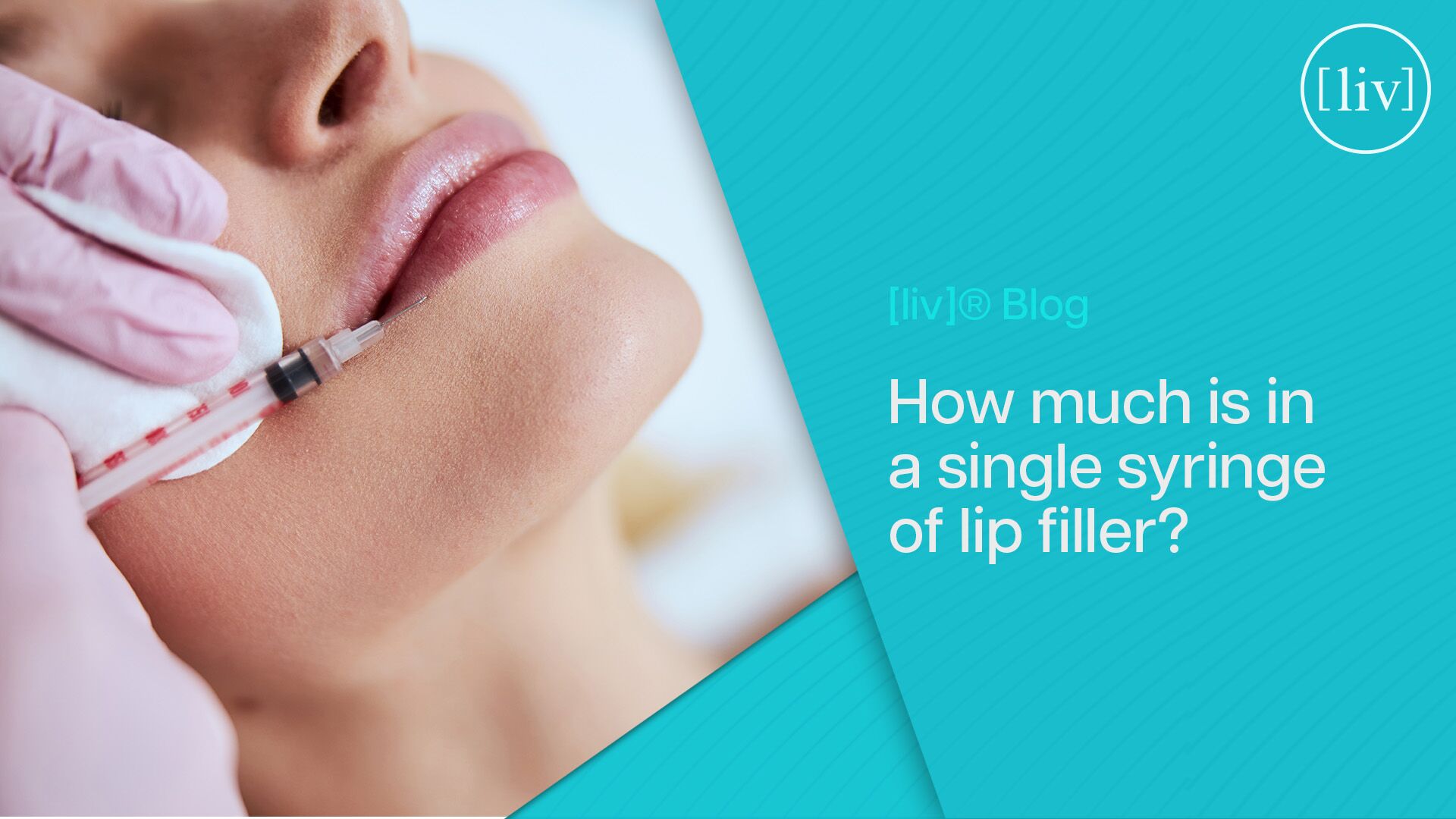Celebrate Mother's Day with Dr. Andrew Ress at [liv]
May 08, 2025
Shine Bright This Holiday Season: Unveil Your Best Self!
December 18, 2024

Discover the volume of lip filler in a syringe and understand the variations in quantity. Learn more about the typical content of lip filler injections and consult with medical professionals for precise information.
The quest for fuller lips has led many individuals to explore cosmetic procedures such as lip fillers. However, before delving into the world of lip augmentation, it's crucial to understand the basics, including the quantity of filler contained within a syringe. This introductory guide sheds light on the varying volumes of lip filler injections, providing insight into what to expect and how to make informed decisions when considering this popular cosmetic treatment.
Lip fillers primarily consist of hyaluronic acid (HA), a naturally occurring sugar in the body. In fillers, HA is in a gel form, which when injected beneath the skin, adds temporary volume. Since HA is naturally occurring, it's safe for injection without the need for allergy testing prior to treatment. The enhancements from injecting fillers into the lips include added plumpness, defined vermilion borders, and smoothed vertical lip lines, making it an ideal choice for those with naturally thin lips or lips that have thinned over time.
The volume of lip filler in a syringe can vary depending on the brand and type of filler being used. Typically, a syringe of lip filler contains between 0.5 to 1.0 milliliters (ml) of filler substance. However, it's important to note that this can vary, so it's best to consult with a medical professional or the product packaging for specific information regarding the volume of filler in a syringe.
Lip fillers have become a popular cosmetic treatment for enhancing the volume, shape, and structure of the lips. With advancements in aesthetic medicine, there are now several types of lip fillers available, each with its unique properties and benefits. Understanding the different types of lip fillers can help you make an informed decision about which option is best for achieving your desired look. Here's an overview of the most common types of lip fillers used today.
Hyaluronic acid fillers are the most popular choice for lip augmentation due to their safety profile, effectiveness, and natural-looking results. HA is a naturally occurring substance in the skin that helps retain moisture and adds volume. When injected into the lips, HA fillers enhance fullness, shape, and definition. They are temporary and can be adjusted or reversed if desired. Common brands include:
While not as commonly used for the lips due to their thicker consistency, CaHA fillers like Radiesse® can be an option for individuals seeking more pronounced augmentation. CaHA is a mineral-like compound naturally found in human bones. In filler form, it's biosynthetically produced, meaning it's allergy-free and doesn't require skin testing. CaHA fillers stimulate natural collagen production, offering long-lasting results.
Poly-L-lactic acid (PLLA) fillers, such as Sculptra®, are "biostimulatory" fillers that don't just add volume but also stimulate the body's collagen production for a more gradual and natural-looking enhancement. PLLA is a synthetic material that is biodegradable and biocompatible. Given its mechanism of action, results appear gradually over several months and can last up to two years. However, PLLA is more commonly used for facial volume loss and may not be the first choice for lip augmentation.

PMMA fillers, like Bellafill®, are semi-permanent fillers that consist of a collagen gel carrying tiny PMMA microspheres. The collagen provides immediate volume and structure, while the PMMA microspheres create a matrix that supports the body's collagen production. Due to their permanent nature, PMMA fillers are used cautiously in the lips and are typically recommended for patients seeking long-term solutions for deep wrinkles and volume loss rather than first-time lip enhancement.
Autologous fat transfer, or fat grafting, involves harvesting fat from another area of the patient's body, purifying it, and then injecting it into the lips. This method is natural and can offer long-lasting results, but it involves a more invasive procedure compared to other fillers. The outcomes can be less predictable, and there's a possibility of needing multiple sessions to achieve the desired volume.
Selecting the right type of lip filler depends on various factors, including your aesthetic goals, the natural shape and volume of your lips, your medical history, and your preference for the longevity of the results. It's essential to consult with a board-certified dermatologist or plastic surgeon who can assess your needs and recommend the most suitable type of filler for your lips. With the right choice and an expert injector, lip fillers can beautifully enhance your natural features, boost your confidence, and achieve the desired aesthetic outcome.
When considering dermal fillers for cosmetic enhancements, one of the most common questions revolves around the amount of filler that is typically used during treatments. The quantity of filler required can vary widely depending on the treatment area, the desired outcome, the type of filler used, and individual facial anatomy. Here's an overview to help you understand how much filler is typically used in various cosmetic procedures.
For facial volume and contouring, such as cheek enhancement or jawline definition, the amount of filler needed can range from 1 to 4 milliliters (ml) or more. These areas often require a larger volume of filler to achieve noticeable results. The exact amount depends on the existing facial structure and the degree of enhancement desired.
Lip augmentation is one of the most sought-after filler treatments. The amount of filler used for lips typically ranges from 0.5 to 2 ml. First-time patients may start with a smaller quantity (about 0.5 to 1 ml) to ensure natural-looking results, with the possibility of adding more filler in subsequent sessions based on their desired outcome.
Treating the under-eye area or tear troughs requires precision and a conservative approach due to the sensitivity and thinness of the skin in this region. Typically, a small amount of filler is used, ranging from 0.5 to 1 ml for both eyes. Using too much filler in this area can lead to puffiness or an unnatural appearance.
For nasolabial folds (the lines that run from the sides of the nose to the corners of the mouth) and marionette lines (the lines from the corners of the mouth down to the chin), the amount of filler needed can vary. Generally, 1 to 2 ml of filler is sufficient for a noticeable yet natural-looking correction.
Filler can also be used to rejuvenate the appearance of the hands by adding volume and reducing the visibility of veins and tendons. The amount of filler used for hand rejuvenation typically ranges from 1 to 3 ml per hand, depending on the level of volume loss.
Lip fillers are a popular cosmetic procedure aimed at enhancing the volume, shape, and overall appearance of the lips. While generally safe when performed by experienced professionals, like any medical treatment, lip fillers come with potential risks and considerations. Understanding these risks and how to mitigate them is crucial for anyone considering this cosmetic enhancement.
Proper aftercare is crucial for healing and achieving optimal results. Follow your injector's advice closely regarding care for your lips post-procedure. Additionally, scheduling a follow-up appointment can help address any concerns or adjustments that may be needed.
While lip fillers are a relatively safe cosmetic procedure with many satisfied recipients, being fully informed of the potential risks and considerations is essential. By choosing a reputable provider and following all pre- and post-treatment advice, you can significantly reduce the risks and enjoy your new look with confidence.
Lip filler quantities are commonly quantified using syringes. The average cost for a lip filler procedure ranges from approximately $675 to $775 for each syringe.
Although the injection of filler into the lips might cause slight discomfort for some individuals, it typically doesn't result in pain intense enough to halt the procedure. In reality, the majority of patients experience little to no pain both during and after their lip injection treatments.
In general terms, administering 0.5 ml of lip filler can lead to understated yet discernible enhancements, typically boosting lip volume by about 5-10%. This quantity is often preferred by individuals seeking a natural appearance, aiming for a modest increase without excessive fullness or volume in their lips.
Grasping the reasons behind the pricing of dermal fillers necessitates an examination of the elements influencing their cost. A significant determinant is the variety of filler chosen. Various fillers come with distinct price tags; for instance, fillers based on hyaluronic acid typically carry a higher cost compared to those made from collagen.
The amount of lip filler in a syringe can vary depending on the specific product and brand used for the procedure. Typically, a syringe contains about 1 milliliter (ml) of filler, which is sufficient for a noticeable yet natural-looking enhancement of the lips. The exact amount required for an individual's treatment can differ based on their desired outcome, the natural volume of their lips, and the specific areas that need augmentation or contouring. It's crucial for patients to consult with a qualified and experienced practitioner who can recommend the appropriate type and amount of filler to achieve their aesthetic goals while ensuring safety and symmetry.
May 08, 2025
December 18, 2024
Copyright © Liv Plastic Surgery 2026. All Rights Reserved

Consultations are complimentary in person or virtual.
We love our out of town patients!
